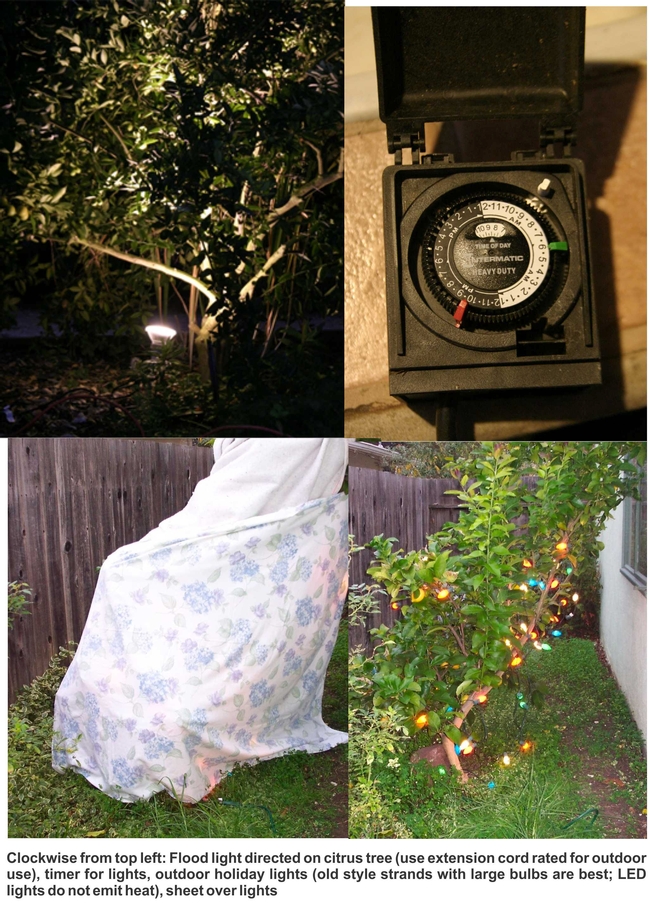As gardeners we often love to push the envelope for our planting zones or desire a plant that may not be well suited to our climate. Some of the popular subtropical plants we love to grow that are marginal in our climate include citrus, avocados and Bougainvilleas. In Napa County, depending on your gardens microclimate, you may be able to grow many plants native to subtropical climates. But these plants need frost protection when temperatures dip into the 30 - 20 degree F range. Some of these plants will tolerate and recover from short exposure to mild frost with only minor frost damage but prolonged frost for several hours or days in a row may kill some plants. Below are some tips for frost protection and for management after frost damage has occurred.
HEALTHY GARDEN TIPS
Web site: http://cenapa.ucdavis.edu
Telephone: 707-253-4221
University of California Cooperative Extension – Napa County
Freeze Protection Simplified
By Dean Donaldson, Farm Advisor Emeritus
1. Make sure your plants are well watered before frost occurs. Well hydrated plants will tolerate colder tempertures and the wet soil will hold some heat.
2. Throw a blanket or sheet, etc. over the plant. Remove when sunny. Recover each night.
‘Engineer’ types can build a cage (OK, but not necessary). Expect burnt leaves and twigs
but plant will be OK. Lightweight fabric or woven cover is superior to plastic.
3. Citrus – fruits will be damaged. Damaged fruit will dehydrate inside. Within a few days
following a frost, fruit should be picked and squeezed. You can freeze juice for later use.
Do not prune until re-growth is visible next spring.
4. Supplemental heat from small wattage bulbs can help reduce frost damage. Use 15
watt, 20-25 watt (outdoor-type) bulb to avoid leaf burn from light bulbs. Outdoor
Christmas lights (larger, old-fashioned) work well if +15 watts (smaller, LED Christmas
lights do not release heat). Place bulb in lower tree canopy and keep lit all night until
temperature is above 32° F. Be sure to also use outdoor-type extension cord and fixture.
5. Do not prune damaged parts until after plants re-grow, usually in April or May.
Frost Protection and best varieties of Citrus to grow in Napa County:
Varieties of citrus with lower heat requirements do best in Napa County. Although frosts are infrequent in the winters near San Francisco and in the thermal belts of many valleys in this region, low-lying inland areas can have temperatures below freezing. Citrus variety, site selection and winter protection are important factors for success in growing citrus in Napa County.
Cold-hardiness depends on the type of citrus grown. Early ripening varieties in our freeze-prone area can facilitate harvesting before the danger of frost. Citron and lime trees are the most tender types, sweet orange and grapefruit varieties are intermediate; and Satsuma mandarins, Meyer lemons and kumquats are the most cold-hardy.
Among sweet oranges Robertson Navel, Skaggs Bonanza, and Washington Navel can be harvested as early as December in Napa County.
Valencia oranges ripen later, but some newer varieties are sold as "improved" Valencias, which ripen earlier, set fruit inside the canopy (more protected), and boast bigger fruit. Three sold under separate names are Delta, Midknight, and Rhode Red.
If blood oranges suit your fancy, Moro is the only choice for color and flavor recommended for Napa County.
Early ripening Clementine Mandarins have excellent flavor. There are many selections, but those that require a pollinizer for good production have seedy fruit. Dancy and Kinnow mandarins, Orlando tangelo, and Valencia orange are commonly used as pollinizers. If you have room for only one tree, choose a variety that does not require a pollinizer. Clementine has produced many hybrids, such as Page, Fairchild, Ambersweet, Lee, Nova, and Robinson. Satsuma Mandarins are the most cold-hardy citrus and the earliest bearer. They can be grown in areas normally too cold for citrus. Ripening occurs before dangerous frost occur, and the foliage survives temperatures to about 22F degrees. Dobashi Beni, Okitsu Wase and Owari are selections that thrive in cooler regions.
The University of California Division of Agriculture & Natural Resources (ANR) prohibits discrimination or harassment of any person in any of its programs or activities (Complete nondiscrimination policy statement can be found at http://ucanr.org/sites/anrstaff/files/107778.doc ). Inquiries may be directed to Linda Marie Manton, Affirmative Action Contact, University of California, Davis, Agriculture and Natural Resources, One Shields Avenue, Davis, CA 95616, (530) 752-0495.
